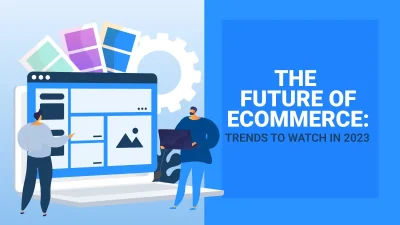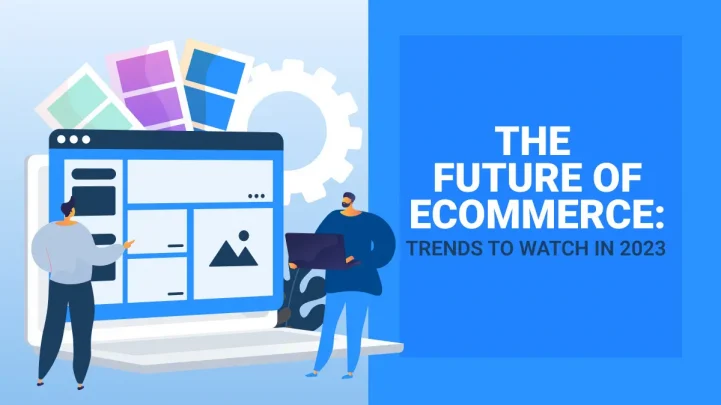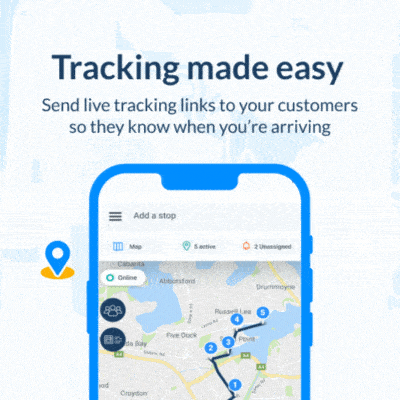Welcome to the enthralling world of online business! The power of technology and the internet has changed the online experience for everyone, leading us all to wonder about the future of ecommerce and trends to watch in 2023.
These days, practically anything can be purchased from the convenience of your home or really from anywhere. The ecommerce revolution in retailing, which has soared in popularity, is to thank for the explosion in online sales. There are countless prospects for success in the e-commerce sector, regardless of the size of the online company.
What’s the future of Ecommerce and what trends to look out for in 2023?
Artificial Intelligence (AI)
When it comes to the future of ecommerce, artificial intelligence (AI) technology has the potential to transform the process and outcomes of shopping online. The ecommerce sector is already seeing a significant impact from AI, and chatbots are one common application of this technology.
A recent study found that 84% of eCommerce companies either actively integrate AI technologies into their operations or have it as a key priority. As a result, the use of artificial intelligence in ecommerce has increased dramatically over the past five years and will only increase going forward.
Chatbots are virtual assistants that may communicate with users through messaging platforms. Customers are satisfied and more inclined to return to the store when they know they can get assistance and answers to problems at any time. Additionally, since ecommerce companies don’t need as many personnel to assist clients, chatbots can save them time and money.
Product recommendations are another way AI is transforming shopping. Machine learning algorithms are used by AI-powered recommendation engines to evaluate consumer behavior and offer tailored product recommendations. Giving customers a personalized purchasing experience that matches their interests and preferences, can enhance sales and customer loyalty.
Another big area where AI is having an impact is personalized marketing. AI can assist ecommerce companies in developing focused marketing strategies that are catered to specific clients by evaluating customer data. Personalized information that appeals to the customer can be sent in this way to enhance conversions and customer engagement.
Along with these applications, artificial intelligence is also applied in fields like fraud detection, inventory management, and pricing optimization. Systems for detecting potential fraud can evaluate transaction data in real-time. They are powered by AI. By anticipating demand and maximizing stock levels, AI can assist ecommerce companies in managing their inventories more effectively. Algorithms for pricing optimization can examine consumer behavior and market trends to dynamically modify prices and boost sales.
In conclusion, AI has already had a substantial impact on e-commerce, and it has enormous potential to completely transform the sector. A few examples of how AI is transforming the ecommerce industry include chatbots, product recommendations, and targeted marketing.

Mobile Commerce (m-commerce)
Mobile commerce, or m-commerce, refers to the exchange of products and services via portable electronic devices like smartphones and tablets. Because of the ease they offer and the growing use of mobile devices, consumer behavior has changed substantially, which has had a huge impact on the ecommerce business.
The widespread use of mobile devices has encouraged mobile purchasing. According to Statista, 72.9% of all worldwide e-commerce sales occurred through mobile devices in 2021. As a result, ecommerce businesses who want to stay competitive must make their websites mobile-friendly. This trend is expected to continue in the years to come.
For online stores, having a mobile-friendly website is essential. Customers utilizing mobile devices will have a seamless and user-friendly buying experience thanks to a website that is mobile-friendly. A website should be mobile-friendly if it loads quickly, responds to diverse screen sizes, and is simple to navigate.
The way people shop online is changing as a result of mobile payment solutions like Apple Pay and Google Wallet. Customers can swiftly and securely conduct transactions using their mobile devices with the help of these payment solutions. Customers no longer need to manually enter their payment and shipping information thanks to mobile payment options, which can enhance conversions and boost customer satisfaction.
Online retailers must adapt to the way that mobile devices are changing consumer behavior in order to remain competitive. When physical retailers seek to draw in more consumers, businesses can use mobile devices to target clients depending on their location. Location-based marketing describes this.
Ecommerce companies must have a mobile-friendly website in order to compete. Businesses need to make sure their website appears excellent on phones and tablets because many people shop online on them. Additionally, the use of mobile wallets like Google Wallet and Apple Pay is expanding. These options allow people to quickly and simply buy anything using their phones.
Augmented Reality (AR)
A technique known as augmented reality (AR) improves the user’s experience by superimposing computer-generated pictures in the real world. AR is being utilized in e-commerce to develop fresh and fun ways for customers to interact with products and make better purchasing decisions.
Virtual try-on is one of the most often used applications of AR in e-commerce. Customers can use this application to virtually try on things without needing to do so in person. For instance, a customer can utilize AR to try on apparel, eyeglasses, or makeup from the convenience of their home. As a result, customers have a more enjoyable and participatory shopping experience, which increases the likelihood that they will make a purchase.
Additionally, AR is being used to give buyers more thorough product renderings. Customers may view products in 3D and spin them to see them from all sides using AR. For items like furniture or home décor, where shoppers want to see how items will appear in their space before making a purchase, this can be especially helpful.
AR-enabled technologies can potentially lower returns and boost consumer happiness for e-commerce companies. Giving clients a more realistic picture of the product will help them make better purchasing decisions, which will result in fewer returns and greater customer satisfaction.
Voice Commerce
People are increasingly adopting voice assistants like Alexa and Google Home to shop online, which is known as voice commerce. People are finding it more convenient to conduct their shopping with voice commands as smart speakers and voice assistants become more prevalent.
Online businesses will be significantly impacted by this trend. Online businesses must make their product listings voice search-friendly in order to capitalize on the expanding voice commerce trend. Voice searches, as opposed to conventional text-based searches, are frequently more conversational and employ more everyday terminology. As a result, it’s important to optimize product listings for long-tail keywords and phrases as well as for more conversational language.
Additionally, voice commerce has the power to completely alter how we make payments for online transactions. Customers might finish a transaction with voice-activated payments by issuing a voice command. This might make it easier for customers to check out and make the process more seamless. Before voice-activated payments become commonplace, there are some security issues that must be resolved.
Overall, voice commerce is a trend that is here to stay, therefore online businesses who want to stay ahead of the competition need to pay attention to it. Businesses may benefit from this expanding trend and give their consumers a better purchasing experience by optimizing their product listings for voice search and investigating the potential of voice-activated payments.
Social commerce
People using social networking sites for their buying is a trend that is quickly taking off in the online retail sector. Social networking platforms like Facebook, Instagram, and Pinterest are becoming practical tools for businesses to interact and engage with prospective customers as a ramification of their rising popularity.
Social commerce has caused an evolution in online purchase behaviors. Instead of using conventional e-commerce websites, consumers now browse and purchase things directly on social networking networks. This trend is particularly popular among millennials, who are more likely to use social media to discover new products and businesses.
Social media marketing has grown to be a crucial component of organizations’ overall marketing plans. Businesses may reach a wider audience and interact with clients more personally by utilizing social media channels. Social media marketing can also assist businesses in advertising their services and goods, resulting in increased brand awareness and attracting more customers to their e-commerce websites.
Social media sites are adding new capabilities to allow businesses to sell directly on their platforms in an effort to better capitalize on the social commerce boom. For instance, Facebook Shops and Instagram Checkout enable companies to provide a seamless purchasing experience within the social media platform. Customers may thus browse products, add them to their shopping carts, and finish their transactions all within the same app.
The emergence of social commerce has both benefits and downsides for businesses. On the one hand, it offers businesses a fresh channel for customer interaction and revenue growth. To stay relevant, businesses must, however, adjust to the shifting customer habits and invest in social media marketing.
The growing trend known as social commerce is altering the ecommerce industry. Businesses can benefit from this trend and reach a larger audience by leveraging social media platforms and increasing their social media presence.
Conclusion
Ecommerce sales are increasing every year, and online shopping has integrated itself into the retail sector. Online shops and ecommerce sites have replaced conventional brick-and-mortar retailers by offering clients accessibility and convenience.
With features like targeted marketing and tailored recommendations, online shoppers now get a more simplified and customized purchasing experience. With just a few clicks, purchases can be completed online, and the growth of social commerce and voice commerce offers even more options for companies to contact clients through cutting-edge platforms.
Businesses must adapt and optimize their online store as ecommerce continues to change in order to meet the shifting demands and expectations of customers. This entails making investments in ecommerce platforms that are easy to use, offering outstanding customer support, and utilizing emerging technology to improve the online buying experience.
Overall, many consumers are now likely to make online purchases, and companies that can provide a simple and fun online shopping experience will prosper in the cutthroat ecommerce.
Enhance your ecommerce store with Locate2u
Having looked at the future of ecommerce and trends to look for in 2023, let’s have a look at Locat2u.
If you’re searching for a solution to improve customer satisfaction and provide customers more delivery choices then Locate2u’s Local Delivery app is perfect for you. Brick-and-mortar establishments have had to change to compete with the growth of ecommerce platforms. Providing local delivery choices is a terrific way to draw in new consumers and keep existing ones, but organizing deliveries may be difficult.
The local delivery software from Locate2u streamlines the delivery procedure so you can concentrate on offering excellent items and customer service. The app provides real-time tracking and notifications so your clients are constantly aware of the location and arrival time of their packages. Additionally, you can customize your delivery experience to match the demands of your consumer’s thanks to the variety of delivery alternatives available.
In today’s fast-paced world, convenience is key, and offering local delivery can be the difference between a one-time customer and a loyal brand advocate. By utilizing our Local Delivery app, you’ll be able to provide your customers with a seamless delivery experience, enhancing their overall experience with your brand. So what are you waiting for?
Start offering local delivery today and watch your ecommerce store grow!
Share this article
About the author
Marketing Coordinator at Locate2u having completed a Bachelor of Creative Arts, majoring in English Literature and Creative Writing. I have extensive experience in editing and proofreading, as well as creating content for a range of audiences.














